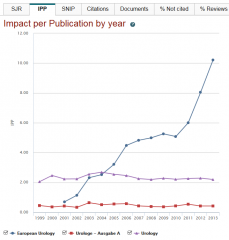
Impact per Publication dreier urologischer Journals
Der Wissensverlag Elsevier hat seiner Zitationsdatenbank Scopus mit Impact per Publication neben Source Normalized Impact per Paper und SCImago Journal Rank nun bereits die dritte durchaus bemerkenswerte Alternative zum Impact Faktor des Konkurrenten Thomson Reuters (Web of Science) hinzugefügt. Im nachfolgenden finden Sie die Pressemeldung des Konzerns:
Scopus adds Impact per Publication (IPP) to its growing portfolio of journal metrics.
IPP measures the ratio of citations per article published. It provides an additional metric for comparing and evaluating journals to help your users confidently know where to publish. Users can access the IPP metric from the Compare journals tool and elsewhere in Scopus.
About Impact per Publication (IPP)
The IPP measures the ratio of citations in a year (Y) to scholarly papers published in the three previous years (Y-1, Y-2, Y-3) divided by the number of scholarly papers published in those same years (Y-1, Y-2, Y-3). The IPP metric is using a citation window of three years which is considered to be the optimal time period to accurately measure citations in most subject fields. Taking into account the same peer-reviewed scholarly papers only in both the numerator and denominator of the equation provides a fair impact measurement of the journal and diminishes the chance of manipulation.
The IPP is not normalized for the subject field and therefore gives a raw indication of the average number of citation a publication published in the journal will likely receive. When normalized for the citations in the subject field, the raw Impact per Publication becomes the Source Normalized Impact per Paper (SNIP). Note that in the context of the calculation of SNIP, the raw Impact per Publication is usually referred to as RIP. Like SNIP, the raw Impact per Publication metric was also developed by Leiden University’s Centre for Science & Technology Studies (CWTS).
Relevant links
- Research Paper: Research Paper: „Measuring contextual citation impact of scientific journals“
This paper explores the methodology behind the raw Impact per Publication and the Source-Normalized Impact per Paper (SNIP). - CWTS website: From this site, you can find raw impact per publication values and related in-depth information about journals.
